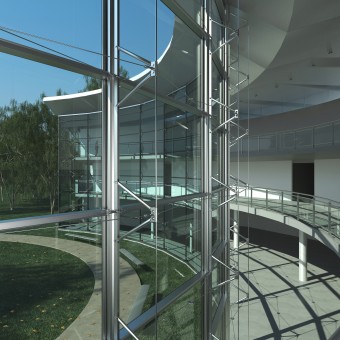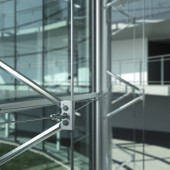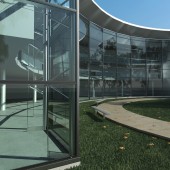DESIGN NAME:
Glasswave
PRIMARY FUNCTION:
Multiaxial curtain wall system
INSPIRATION:
Without a doubt, the notion of natural light and its penetration quality in an interior space is a fundamental element of architecture. Ever since Mies van der Rohe’s experiments in incorporating glass walls into new buildings, the curtain wall concept has made respectable advances.
UNIQUE PROPERTIES / PROJECT DESCRIPTION:
The GLASSWAVE multiaxial curtain wall system opens the door to greater flexibility in designing glass walls for mass production.
This new concept in curtain walls is based on the principle of vertical mullions with cylindrical rather than rectangular profiles.
This definitively innovative approach means that structures with multidirectional connections can be created, increasing tenfold the possible geometric combinations in glass wall assembly.
OPERATION / FLOW / INTERACTION:
When we consider the products that are currently mass produced, we can see that the accent placed on the economic factor and the effort to simplify assembly (in the factory and on-site) tends to limit architects’ creativity to design light-filled, convivial environments, unless they customize the existing products to fit their design.
In fact, if architects want to go beyond the simplest applications (straight walls and geometrical edges where panels meet at predetermined angles: 90, 45, 30 degrees) to carry out more complex projects, they must either use a “spider” type of product from Europe, or convert mass production systems to produce custom designs. These solutions bring about significant costs and often to disappointing visual and/or structural compromises.
PROJECT DURATION AND LOCATION:
This project took 3 years of development ending in 2011
It's been created and produced in Montreal Quebec Canada
FITS BEST INTO CATEGORY:
Building Materials and Construction Components Design
|
PRODUCTION / REALIZATION TECHNOLOGY:
-
SPECIFICATIONS / TECHNICAL PROPERTIES:
-
TAGS:
Innovative curtain wall system -- Based on cylindrical mullions instead of rectangular -- Multidirectional glass wall --made for distinctive buildings, atriums, spectacular show-rooms etc. --an advanced tool for architectural expression -- greater flexibility in designing glass wall projects --integrated trusses --encourage architects to design bolder projects, even when the budget is a significant factor -- GlassWave solves the problem of various meeting angles in curtain wall projects
RESEARCH ABSTRACT:
INNOVATIVE CHARACTERISTICS :
The GLASSWAVE system was designed based on the principle of a vertical mullion with a cylindrical profile rather than a rectangular profile. This enables the horizontal mullions around the vertical mullion to pivot and, with the same components, to standardize the way in which the glass panels meet at angles that vary from 90 degrees internally to 90 degrees externally, in a continuous increment.
This is a hybrid system, in that the principle of horizontal mullions with rectangular profile is retained, making it easier to adapt the numerous specialized parts that already exist, such as door and window assemblies, which can be integrated as a subsystem into the GLASSWAVE structure itself. This approach constitutes a highly advantageous asset because it avoids the need to redesign a complex and expensive group of components.
One of the key points of the concept lies in the principle of a horizontal mullion with a “sliding “nose,” which cleverly and elegantly solves the problem of the meeting angles. Various kinds of joint finishing may be used: silicone joints, with horizontal and/or vertical snap-on caps.
Thanks to the regularity of the structural pattern and the perfect order of the centre distance between the vertical mullions, at any angle where the panels meet, the system offers great refinement in it’s architectural expression, especially in curved wall configurations.
Furthermore, integrating trusses into the structure creates beneficial solutions on the design level and also in the project management of the building.
CHALLENGE:
The major challenges in designing the GLASSWAVE multiaxial curtain wall system were related to the nordic climate which brings extreme conditions of cold, humidity, wind, warmth, all creating heavy condensation effects. Considering these facts, we wanted to create a very refined structure, always requested by architects in their search for abstraction and purity in formal expression. So we had to develop components such as aluminium mullions, gaskets, joints, clips etc. showing the finest details to drag their attention. Dipping into the architectural vocabulary of ultra-high-end products, the GLASSWAVE system, while remaining a quite affordable product for this category, will encourage architects to design bolder projects, even when the budget is a significant factor.
The main objectives were also to design a system allowing us to break free from the limitations of the current products and to develop a much more flexible design tool that favours creating variable geometry glass panels without having to resort to costly custom design, and to do it at competitive prices.
ADDED DATE:
2012-02-24 09:01:51
TEAM MEMBERS (2) :
Charles Godbout, industrial designer and -- Luc Plante, architect
IMAGE CREDITS:
Charles Godbout and Luc Plante, 2011.
|










